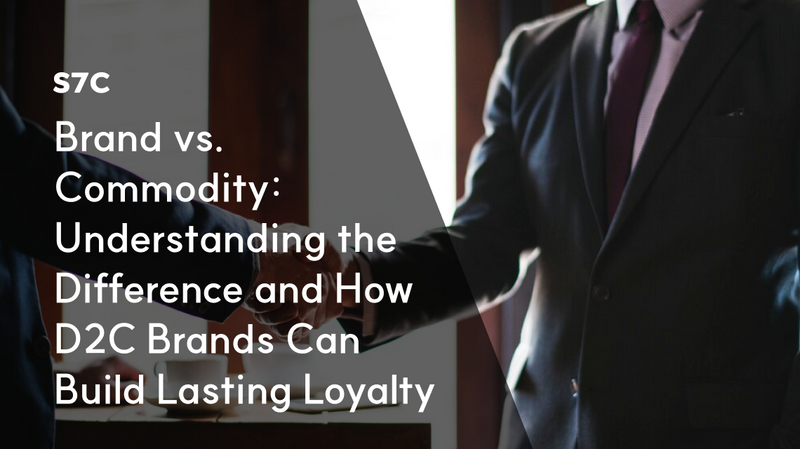In This Article
Distinguishing between brands and commodities is a complex task for D2C brands. The line between standing out and blending in often lies in how consumers perceive products.
Are they connecting emotionally or simply comparing prices? If customers find the offering as easily replaceable, then it’s time to rethink the approach.
This article provides a detailed understanding of brand vs. commodity. It also explains the best strategies that help businesses cultivate D2C brand loyalty and stand apart in a crowded e-commerce space.
Understanding Consumer Perception: Brand vs. Commodity
The primary difference between a brand and a commodity lies in customer perception. Think of a plain coffee bean. Unbranded, it’s just another bean, but in a Starbucks cup, it commands a premium one. The power of branding drives this transformation from commodity to brand.
Here's a comparative table highlighting the distinctions between brands and commodities:
| Aspects | Brand | Commodity |
| Consumer Perception | Evokes emotional connection and loyalty | Viewed as interchangeable and price-driven |
| Value Proposition | Offers unique value beyond the product | Lacks differentiation; price is the main factor |
| Pricing Power | Can command premium prices | Competes mainly on price, limiting margins |
| Customer Experience | Delivers a curated, memorable experience | Basic, often functional, with no frills |
| Marketing Approach | Focuses on storytelling and engagement | Relies on generic promotion, often price-led |
| Customer Loyalty | Builds lasting relationships and loyalty | Struggles to retain customers long-term |
| Brand Equity | High, with a recognizable identity | Low, often indistinguishable from others |
Grasping the finer points of brand vs. commodity will shape strategy, helping businesses stand out and build lasting customer loyalty.
Building D2C Brand Loyalty: 3 Effective Strategies
Here are the top three strategies essential for any D2C brand looking to escape the commodity trap and build a powerful, lasting brand presence:
1. Develop Emotional Connections to Elevate Brand Loyalty
Brands excel by creating emotional connections, unlike commodities, which compete solely on price. Take Nike, for example - what was once a regular sneaker is now a symbol of aspiration and style that customers willingly pay a premium for.
This emotional connection creates loyalty, as customers feel positive and valued with each interaction. When a brand speaks to a customer's values or lifestyle, it becomes more than a product; it becomes part of their identity.
Brands like Apple and Coca-Cola have mastered this by speaking directly to their customers' identities, turning simple purchases into emotional decisions.
The key question for D2C brands is, “How does my brand make people feel?” By crafting an emotional experience, businesses position their brand as irreplaceable, driving deeper loyalty and setting them apart from commoditized alternatives.
2. Invest in Visibility to Strengthen Brand Presence
Visibility is a cornerstone of successful branding. Top brands like McDonald's and Amazon have become ingrained in the global culture through consistent presence and quality. Visibility builds awareness, which in turn generates demand and sales.
To increase their brand visibility, businesses must invest in a strong visual identity and tailor their services to address specific customer needs. Referrals and targeted social media efforts also help build a recognizable and trusted brand.
When customers see and remember a brand, they are more likely to choose it over a generic alternative.
3. Prioritize Long-Term Brand Commitments over Short-Term Wins
Successful brands prioritize long-term relationships over immediate profits. Apple’s success isn’t just about the quality of its products but the trust and expectations its brand promises. This long-term commitment builds a loyal customer base willing to pay more because they believe in the brand’s value.
D2C brands should consistently deliver on their promises, exceed customer expectations, and maintain premium service quality. Ignoring this can lead to a loss of trust and brand differentiation in the market.
A clear and consistent brand promise helps a business stand out and command higher prices. To build this, businesses must understand their target audience, offer premium services, and consistently deliver exceptional customer experiences.
Crafting 3 Effective D2C Brand Strategies
D2D brands thrive on innovative strategies that go beyond traditional retail models. Implementing the following strategies can help D2C brands build stronger connections with their audiences:
1. Build an Engaged Community
Creating a strong and actively engaged community is essential for D2C brands aiming to thrive in today’s market. Instead of merely focusing on building a large follower base with limited interaction, successful brands put the community at the heart of their strategies.
They encourage customers to engage with their content, share posts, and tag friends. This approach increases brand visibility as well as leads to higher conversion rates.
Brands that excel in community building often see over 75% of their content generated by users. They also achieve an influencer engagement rate of over 2% and convert more than 4% of online traffic into sales.
To get started, brands must identify the communities they wish to engage with - be it specific interest groups, geographical locations, or shared values. Understanding these communities on a deep level, including their needs and preferences, is critical for creating meaningful connections and building brand loyalty.
2. Emphasize Core Values and Sustainability
Authenticity is key - brands must align their sustainability efforts with their core values to build genuine connections with consumers.
Today's consumers, especially younger, environmentally conscious buyers, increasingly value brands with ethical and sustainable practices. That's why companies that demonstrate their commitment to environmental, social, and governance (ESG) initiatives can differentiate themselves in the market, attracting both customers and talent.
3. Create Exceptional Customer Experiences
With product differentiation narrowing, customer experience has become a crucial brand differentiator. Brands should focus on delivering consistent and exceptional service across all touchpoints, from personalized content and seamless website navigation to proactive customer support.
A well-defined customer journey, supported by a strong internal culture, helps ensure that every interaction reinforces positive brand perceptions, setting the stage for long-term loyalty.
Wrapping Up!
A brand is a company's greatest asset - it defines its identity in the market. If a business does not actively shape its brand, external forces may redefine it, making it difficult to reclaim control. To stand out and avoid becoming a commodity, companies should align their innovative products with strategies that highlight every brand touchpoint. Authenticity, social responsibility, and an exceptional customer experience are critical to protecting and elevating a brand.
To build long-lasting customer loyalty, consider Seventh Triangle, a leading MarTech agency that specializes in helping D2C brands thrive in the digital landscape. Contact us today to build successful digital journeys for D2C businesses with complete 360° solutions.




